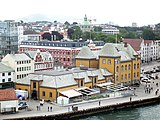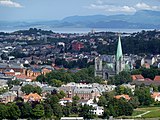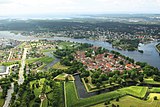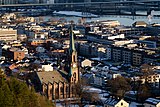Norway
Template:Infobox State/Maintenance/NAME-German
Norway (Norwegian: Norge (Bokmål) or Noreg (Nynorsk); North Sami: Norga; Lulesam: Vuodna; South Sami: Nöörje), officially the Kingdom of Norway or Kongeriket Norge/Noreg is a country in northern Europe. The Kingdom of Norway includes the mainland, the archipelago of Spitsbergen, and the island of Jan Mayen. The capital and seat of government is Oslo. The country is located in the west of the Scandinavian Peninsula and borders Sweden to the east and Finland and Russia to the northeast. Norway is one of the largest countries in Europe in terms of land area, but is sparsely populated with a population of only 5,391,369 as of January 1, 2021. Much of the population is concentrated in the south of the country.
As a result of the agreement between Sweden and Denmark at the Peace of Kiel, Norway passed from the Union of Denmark-Norway to a Union with Sweden in 1814. On 17 May 1814 Norway received its own constitution. Norway finally gained its present independence when the union with Sweden was dissolved in 1905. Norway's form of government is a parliamentary monarchy. The kingdom is organized as a decentralized unitary state and the main country is divided into eleven fylker. Norway is a member of NATO, the Nordic Council, the Organization for Economic Cooperation and Development (OECD), the European Free Trade Association (EFTA), and the United Nations, among others. Norway is not a member of the European Union (EU), but is a member of the European Economic Area (EEA).
The United Nations Human Development Index (HDI) has ranked Norway as the world's most developed country for many years. It is also the most democratic country in the world, according to The Economist magazine's Democracy Index. Norway is a very wealthy country; its gross domestic product per capita was the third highest in the world in 2016. The country also has one of the most generous and best welfare systems in the world.
Geography
|
|
→ Main article: Geography of Norway
Extent and limits
Norway is located in the western and northern part of the Scandinavian Peninsula. The territory of the Kingdom covers an area of 385,207 km². In addition to the continental "mainland" (Norwegian: Hovedland), the Kingdom of Norway includes the archipelago of Spitsbergen (Svalbard) with the Bear Island (Bjørnøya) and the island of Jan Mayen, located in the North Atlantic and the Arctic Ocean. Without Svalbard and Jan Mayen, the mainland is 323,808 km².
The mainland is long and narrow and also has a very long coastline. The width of the Norwegian mainland varies between 431 and 1.7 km, the longitude is about 1748 km as the crow flies. Cape Kinnarodden is also the northernmost point of the European mainland. Norway has three land borders, the border to Sweden in the east as well as the Finnish-Norwegian border and the border to Russia in the northeast. In total, the Norwegian land border reaches a length of about 2564 km. The country is surrounded by sea to the north, west and south, with the Barents Sea to the northeast, the European North Sea to the northwest, the North Sea to the west and southwest, and the Skagerrak to the southeast, which connects the North Sea and the Baltic Sea. Norway's economic zone borders Denmark in the North Sea to the south and the United Kingdom to the west.
Areas that are under Norwegian administration but do not enter the Kingdom of Norway are referred to in Norwegian as Biland. These include the uninhabited Bouvet Island (Bouvetøya) in the South Atlantic. Furthermore, Peter I Island (Peter I Øy) in the Southern Ocean and Queen Maud Land (Dronning Maud Land), a sector of the continent of Antarctica, are claimed by Norway. Sovereignty over the areas classified as Biland, unlike the areas belonging to the Kingdom, can be relinquished without an amendment to the Constitution.
Geology and landscape structure
Norway is one of the most sparsely populated countries in Europe. In the area statistics of 2020, 1.7 % of the total area was designated as built-up area. 37.4 % was considered as forest area and 3.5 % as agricultural area. Over 50% of the total area was classified as mountain, plateau or moorland, and another 7% as water bodies or glaciers. In terms of landscape, Norway is characterised by the ScandinavianMountains with mountain massifs and barren plateaus, the Fjells. The highest elevation of the mainland is the mountain Galdhøpiggen with 2469 moh, located in the mountain range Jotunheimen. About 20 % of the Norwegian mainland lies at an altitude of at least 900 moh.
The Norwegian basement is roughly divided into four areas. The Baltic Shield, for example, comprises the Norwegian bedrock formed during the Precambrian period. In the municipality of Sør-Varanger, the oldest rocks in the country are reported to be up to 2900 million years old. Another area is the Caledonianmountain belt formed at the end of the Silurian period. Especially in the regions of Vestlandet and Trøndelag there is a bedrock created during the Devonian geochronological period. The fourth area is the Oslograben (Oslofeltet in Norwegian), which is the youngest of the four main areas.
Surface modelling occurred mainly through glaciation during the cold periods. The glaciers increased erosion and created, among other things, U-shaped trough valleys and on the coast river valleys were deepened into fjords. Many inland lakes (see list) were also formed by glaciers or ice sheets, so they are fjord lakes. The largest lake is Mjøsa with an area of approximately 369 km², the deepest lake is Hornindalsvatnet with a depth of 514 metres.
The longest rivers in Norway are the Glomma, the Tana and the Pasvikelva. The Glomma is about 620 km long and flows into the Oslofjord near Fredrikstad. The river's catchment area accounts for over 12 percent of the area of mainland Norway. Compared to other European countries, the catchment areas of Norwegian rivers are usually relatively small. The reason for this is that the highest elevations of the Scandinavian Peninsula are found in the west near the Atlantic coast and thus the main watershed is close to the coast.
Coast
The approximately 29,000 km long coastline of the Norwegian mainland consists of many narrow and deep bays, the fjords, with which the salty sea reaches far into the country in many places. The 200 km long Sognefjord in the Fylke Vestland is the longest and deepest fjord of Norway. If the coastlines of the islands are included, the coastline of the mainland reaches a length of more than 100,000 km. The baseline of the coast without the fjords and islands, however, is only about 2500 km long. About 80% of Norway's population lives less than ten kilometres from the sea. The country is surrounded by about 239,000 islands. The island of Hinnøya is the largest island in the Norwegian mainland with an area of 2204 km².
The coastal areas are shaped by various factors and differ regionally. Large parts of the coasts are rocky, sometimes there are steep cliffs like at the North Cape. In more sheltered places there is some sandy beach, such as in Fylke Rogaland. In some parts of the coast there are rocky skerries that barely rise above the waves. The Norwegian Continental Shelf is particularly exploited by the oil and gas industry.
The behaviour of the tides is very different from the southern and western coasts of the North Sea. West of the southwestern Norwegian town of Egersund lies an amphidromic centre, which is why there is no tidal range there. Accordingly, on the southeast and southwest coasts of Norway, the tidal range is small. Further away from this centre, however, i.e. on the more northerly west coast, the tidal range is greater.
Climate
The climate in Norway is characterised by great differences between the different areas of the country. The Scandinavian Mountains separate the narrow, humid coastal strip in the west from the continental climate in the east. Norway's west coast has a mild and humid climate for its northern latitude. The reason for this is the North Atlantic Current, which allows relatively warm water to flow far north. The moderating effect of the sea - due to onshore winds - can be felt in the air temperatures.
The moisture in the air absorbed from the sea rains down on the western side of the mountains. On the coast there are places with over 3000 mm of precipitation in an average year. In the lee of the mountains the rainfall is rather low. Along the entire coastal strip, the amount of precipitation is significantly lower in spring than in autumn.
Further inland, the climate is more continental. This is due to the shielding effect of the mountains, as the actual distance to the coast itself would not make such a big difference. In the interior, precipitation decreases, temperatures are higher there in summer, but significantly lower in winter than at .
Cities and metropolitan areas
In addition to the population figures for the municipalities, the Norwegian statistics authority Statistisk sentralbyrå also publishes figures for so-called Tettsteder, i.e. more densely populated areas regardless of the municipal boundaries. Thus, as of 1 January 2020, Oslo municipality had 693,494 inhabitants, while 1,036,059 inhabitants were reported for Tettsted Oslo. The Tettsted Oslo also included 115,134 inhabitants of the municipality of Bærum and 68,132 inhabitants of the municipality of Asker.
Most populous Tettsteder (as of 1 January 2020)
|
| Tettsted | Fylke | Inhabitants | Area (km²) |
| |
| 01 | Oslo | Oslo, Viken | 1.036.059 | 269,8 | ||
| 02 | Bergen | Vestland | 259.958 | 87,6 | ||
| 03 | Stavanger/Sandnes | Rogaland | 228.287 | 79,7 | ||
| 04 | Trondheim | Trøndelag | 189.271 | 58,3 | ||
| 05 | Fredrikstad/Sarpsborg | Viken | 116.373 | 59,1 | ||
| 06 | Drammen | Viken | 109.416 | 47,3 | ||
| 07 | Porsgrunn/Skien | Vestfold og Telemark | 93.778 | 53,5 | ||
| 08 | Kristiansand | Agder | 64.596 | 25,0 | ||
| 09 | Ålesund | Møre og Romsdal | 53.905 | 28,4 | ||
| 10 | Tønsberg | Vestfold og Telemark | 53.018 | 26,1 |
See also: List of cities in Norway
flora and fauna
National Parks
→ Main article: National parks in Norway
There are 40 national parks and over 3100 nature reserves on the Norwegian mainland. This means that at the end of 2019, about 17.5% of the area of the Norwegian mainland was protected. The Kingdom's other seven national parks are located on the archipelago of Spitsbergen, where over 64% of the land area had protected status at the same time. On the island of Jan Mayen, the figure was 99.5 %.
Seed plants and ferns
Norway is home to over 1300 species of seed plants and ferns, with over half of the plant species thriving in forest areas. In deciduous forests, the incidence of light on the forest floor changes greatly with the seasons. Therefore, many spring flowering plants are found in deciduous forest. In the coniferous forest, plants live under constant light conditions because conifers do not shed their needles seasonally. Consequently, plants on the ground are constantly exposed to varying degrees of shade. In addition, there are two different types of coniferous forest in Norway, the spruce forest and the pine forest. In the wetter climate of the spruce forest, more arctic species grow than in the dry pine forest.
In Norway there are over 40,000 lakes and many bogs and marshes located in forested areas. Places that provide sufficient nutrients and are rich in minerals have a high species diversity. In other areas with few nutrients, only a few species thrive, but these are all the more numerous. The forest lakes change in appearance and ecology. Most of the forest lakes with no inflow or outflow are dystrophic waters with few nutrients and little oxygen. The water is brown in color and the bottom is muddy. There is often peat at the edges of the banks. Other lakes are shallow and get all their nutrients from rainwater. Peat often forms there because no plant remains can decompose in the oxygen-poor bog soil.
When water seeps in steadily from the mountains, lush vegetation develops. Such areas were popularly called hay bogs because the people used to harvest the grass. The large lakes in Norway are mostly oligotrophic. The water is clear with great depth of visibility and also low in nutrients. The bottom consists of stones, gravel and sand. The flora here is different from that in the forest lakes.
Moose
There are over 800 species of mosses in Norway. The majority of these are found in forest areas. They also colonise bogs and wetlands as well as slow-flowing, stony streams and rivers. The most common moss in water is the common spring moss (Fontinalis antipyretica), which can grow up to 20 cm long. In bogs and wetlands, sphagnum mosses dominate, of which 25 species are known in Norway. In the past they were used as insulating material for building houses. In Vestlandet, where a humid climate allows for a long growth period, layers of peat moss over three metres thick are known. Because of its size and slow growth, mosses in the forest are relegated to sites with little competition, such as stones, woods, sandy slopes and dark forest areas.
Mushrooms
There are 10,000 species of fungi in Norway, of which about 6000 are native to the forest. Only about 2500 of these species produce fruiting bodies in autumn. The Polyporaceae are the most important group of wood-degrading fungi, of which there are over 300 species in Norway. These fungi cause a lot of damage in forestry.
Fauna
Due to the large size of the country, the difference in wildlife between the south and the north of the country is marked. In the north, where reindeer, mountain lemmings, arctic foxes and wolverines, among others, live, it is Arctic in character. Arctic foxes are a highly endangered species and have been protected since 1930. The animals living in the south often originated in Central Europe and displaced the Arctic animals when the climate became milder.
In total, there are about 90 species of mammals in Norway. The largest mammals in the country are the moose, which live in the forests. Deer live mainly in western Norway, further north they cannot find food in the deeper snow. Both domesticated and wild reindeer live in Norway. Predators in the country include bears, wolves and lynxes. Furthermore, polar bears are native to Spitsbergen. American mink spread throughout the country after escaping from farms. Musk oxen have been successfully introduced to Dovrefjell. Norway's bird life is rich in species. In 2020, the number of bird species was reported to be 519. In contrast, the species diversity of amphibians and reptiles is relatively poor. Three species of snakes are found in Norway: The adder, the grass snake and the smooth snake. There are also some toads, frogs and newt species.
In Norwegian waters live 44 species of freshwater fish. Vestlandet is mainly home to species that can also survive in salt water. These include salmon and trout. The fish population is richer in Østlandet and northern Norway. Carp fish live mainly in the warmer lakes and river courses in the south-east of the country. Common species in northern Norway include perch and pike. There are also some whale species off the Norwegian coast.
_with_cub,_Svalbard.jpg)
Polar bears on Spitsbergen
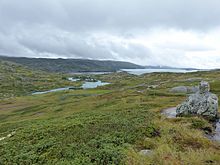
Mosses and lichens on Hardangervidda
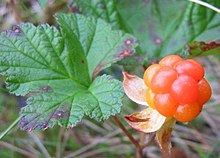
Ripening cloudberry
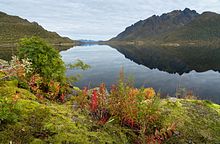
Nature on Austvågøya
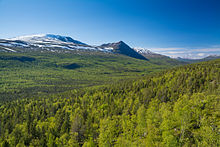
Pines and birches in Øvre Dividal National Park

North Atlantic Current (red) and Norwegian Current (orange)
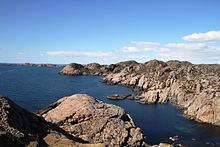
coastline near Lindesnes

Nordland coastline

Geirangerfjord in Møre og Romsdal
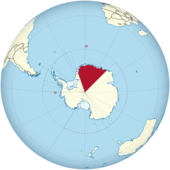
Map of the so-called Biland
Population
→ Main article: Norwegian
Demographics
The median age in Norway in 2020 was 39.5 years. There were 12.09 births and 8.01 deaths per 1000 inhabitants in the same year. The population grew at about 0.8% per year. The fertility rate was 1.84 children per woman. In the 20th century, the country's population more than doubled, from 2.22 million (1900) to 4.48 million (2000). The five million population mark was passed in 2012. The main reason for the strong population growth after 2000 is the increasing number of immigrants.
| Main countries of origin of immigrants (1 January 2020) | ||
| Rank | State | People |
| 1. | Poland | 115.416 |
| 2. | Lithuania | 47.304 |
| 3. | Somalia | 43.273 |
| 4. | Sweden | 38.854 |
| 5. | Pakistan | 38.674 |
| 6. | Syria | 36.026 |
| 7. | Iraq | 34.268 |
| 8. | Eritrea | 29.102 |
| 9. | Germany | 28.258 |
| 10. | Philippines | 26.334 |
| Population development | |
| Year | Population |
| 1950 | 3.250.000 |
| 1960 | 3.568.000 |
| 1970 | 3.863.000 |
| 1980 | 4.079.000 |
| 1990 | 4.233.000 |
| 2000 | 4.478.000 |
| 2010 | 4.858.000 |
| 2020 | 5.368.000 |
Population and ethnic groups
The country's population is distributed 82% (as of 2020) in areas assessed as Tettsteder and 18% in the remaining areas. One of the most densely populated regions in the country is the area around the Oslofjord. The interior, on the other hand, has a low population density and the population there lives mainly in the valleys through which the main communication arteries pass. Overall, about 80% of the country's inhabitants live less than ten kilometres from the sea, and in northern Norway 90% of people live less than four kilometres from the sea.
Norway is probably home to the largest group of Sámi, an indigenous people living in northern Fennoscandia. It is estimated that there are between 60,000 and 100,000 Sámi in Norway, but no precise data is available. The Sámi in Norway are divided into the Southern Sámi, the Pite Sámi, the Lule Sámi and the Northern Sámi. In the municipality of Karasjok, the Sami population has its own parliamentary representation in the form of the Sameting. While the Sami are legally regarded as the indigenous population, the Forest Women, the Kven, the so-called Tatere, the Roma and the Jews have a status as a national minority. In the 2019 Freedom in the World country list, Norway scored 100 out of a possible 100, but it was noted that discrimination against Roma and other minorities remained a problem.
As of January 1, 2020, about 979,000 immigrants resided in Norway, which includes people whose parents were both born abroad. About 790,000 people immigrated from abroad themselves; 189,000 people were born in Norway. In Oslo, about one in three residents belonged to the immigrant group. In 2017, about 800,000, or 15.1% of the population, were foreign-born.
Languages
→ Main article: Norwegian language
Norwegian is a North Germanic language closely related to Danish and Swedish. The written language is divided into two legally equal varieties: about 85-90% of the natives write a form of the language known as Bokmål (literally "book language") or, until 1929, Riksmål ("imperial language"), which can be regarded as a variant of Danish influenced by the urban dialects of Norway. About 10-15%, on the other hand, write Nynorsk ("New Norwegian"). This language, which was called Landsmål ("national language") until 1929, has been recognized as the second official written language since 1885; it was created by Ivar Aasen on the basis of Norwegian dialects and later developed further. In the spoken language, dialects play a greater role than in many other countries.
The languages spoken by the Sámi from the Sami language family have equal legal status with Norwegian. As the Sámi hold the status of Norway's indigenous people, the Sami languages are given greater protection than the other minority languages. The Sámi language family is subdivided into the Northern, Lule, Southern, Pite and Umesam languages, among others. As part of the Norwegianization policy, the use of these languages was suppressed for a long time from the middle of the 19th century. Other minority languages include Kvenish, brought to the country by Finnish immigrants, and Romani. Norwegian Sign Language was recognized as a full language in 2009. Norwegian pupils usually learn English as their first foreign language and later German, Spanish or French as an optional subject.
Religions and world views
Religions
In the constitution of 1814, the Evangelical Lutheran religion was appointed the public religion of the state, and Jews were excluded from access to the Norwegian realm. The corresponding paragraph was repealed in 1851 and all inhabitants of Norway were given the right to practice their religion freely. The number of Jewish citizens in 1940 was about 2170, of which 767 were deported to the Auschwitz concentration camp during the German occupation of Norway (see main article: History of the Jews in Norway).
The largest denomination, even after the introduction of religious freedom, remained the Evangelical Lutheran People's Church, led by the President of the Bishops' Conference. In 2019, it had 3,686,715 members, representing 69% of the population, although membership was declining. A constitutional amendment in 2012 loosened the link between the state and the church, but the People's Church continues to occupy a special role vis-à-vis the other religious communities. For example, the payment of salaries of church employees is supported by the state. Discrimination on the basis of religious affiliation is prohibited by law. From the age of 15, every person has the right to join or leave religious communities.
In 2019, an estimate from the Swedish Central Bureau of Statistics (Statistisk sentralbyrå) on membership of religious communities has provided the following figures:
- Members of the Church of Norway: 70
- Muslims: 3.2
- Roman Catholic Church: 3 %.
- Other Christians: 3.7
- Other: 2,5 %.
- without religious affiliation: 17 %
Other religions included about 21,000 Buddhists, 11,400 Hindus, 4000 Sikhs and 800 Jews. The majority of those who were members of a religious community outside the Church of Norway belong to the immigrant group, i.e. they immigrated to Norway themselves or have two foreign-born parents. They are mostly of Roman Catholic or Muslim faith, depending on their country of origin.
Weltanschauungsgemeinschaften
In Norway there is a humanist association, the Human-Etisk Forbund, a worldview community of non-religious and non-denominational people. The association was founded in 1956. At the end of 2019, it had around 94,000 members, making it the largest association of its kind in Norway.
Education
| Subjects taught in primary school |
| from. 1st class |
| Norwegian |
| Mathematics |
| Science |
| Christianity, religion, outlook on life and ethics |
| English |
| Sports |
| Arts and crafts |
| Music Education |
| Food and health |
| from the 8th grade up |
| Second foreign language |
| Electives |
In Norway, education is compulsory for children from the age of six until the end of tenth grade. All children have the right to attend a public school free of charge. Attendance at private schools and home schooling is also permitted. Furthermore, all pupils have the right to attend a secondary school (videregående skole) after primary school. Compulsory education was introduced in 1739. In 1889 it was established that compulsory education lasted seven years. Later the duration of compulsory education was extended, in 1969 it was set at nine years and in 1997 at ten years.
Kindergartens, along with schools, are also subject to the Ministry of Education. They are run by the municipalities or privately. In 2020, 92.8 per cent of children aged between one and five attended a kindergarten, while the figure for children aged between three and five was 97.3 per cent.
The ten-year primary school (grunnskole) is divided into a seven-year stage for children (barnetrinn) and a three-year stage for young people (ungdomstrinn). The majority of pupils attend secondary school after completing primary school. This is divided into study-preparatory school branches, which correspond to the upper secondary school, and vocational-preparatory school branches. Technical schools (fagskoler) offer vocational training after the secondary school.
Sami pupils have the right to instruction in a Sami language. For immigrant children of school age, the Norwegian state must offer language courses in every municipality.
There are ten universities and six scientific universities in Norway. In 2019, 34.6 per cent of Norwegians over the age of 16 had a university or college degree, three per cent had a technical college degree and 37 per cent had a secondary school diploma as their highest qualification. In the 2015 PISA rankings, Norwegian students score 19th out of 72 countries in mathematics, 24th in science and 9th in reading comprehension. Norway is thus in the top third among the OWCE countries.
See also: List of universities and colleges in Norway and Folk high schools in Norway
Standard of living
The standard of living in Norway is among the highest in the world, ranking first in the Human Development Index almost consistently since 1996 (as of 2020).
| Standard of living | |
| Birth rate | 12.09 per 1000 inhabitants |
| Fertility rate | 1.84 Children per woman |
| Maternal mortality (2017) | 2 per 100,000 Geb. |
| Infant mortality | 2,34 per 1000 Geb. |
| Mortality | 8.01 per 1000 inhabitants |
| Life expectancy | 82.35 years |
| Life expectancy (men) | 80.21 years |
| Life expectancy (women) | 84.6 years |
| Access to clean drinking water | 100 % |
| Doctors (2017) | 2.83 per 1000 inhabitants |
| Hospital beds (2017) | 3.6 per 1000 inhabitants |
| HIV/AIDS infected (2018) | 5800 |
Employment
According to the statistics authority Statistisk sentralbyrå, a total of 2,681,548 were employed in the fourth quarter of 2020. This corresponded to approximately 66% of the population aged 15-74. The number of people registered as unemployed in this age range was reported to be 108,987 in November 2020, which was an increase of 83% compared to the previous year and an unemployment rate of 4.1%. Immigrants were disproportionately affected by unemployment in the fourth quarter of 2020, with a rate of 9.2%.
Women's rights
Norway is considered a pioneer in women's rights. The Norwegian Women's Rights Association, for example, was founded as early as 1884 by many of the most prominent personalities of the time, including several prime ministers.
Women were allowed to vote in regional elections as early as 1901. However, it was a prerequisite that they owned land or were married to landowners. In the 1906 election, the proponents of women's suffrage supported the radicals, and a victory for the radicals led to those women who already had regional suffrage being given that right at the national level as well in 1907. In 1913, all restrictions were lifted. Norway thus became the fourth country in the world to introduce women's suffrage in 1913, after New Zealand, Australia and Finland.
In 1978 Eva Kolstad became the world's first Ombud for Equality.
Norway ranked second behind Iceland in the Global Gender Gap Report 2020, which measures gender equality in a country.

The commercial high school in Bergen

Heddal Stave Church in Notodden
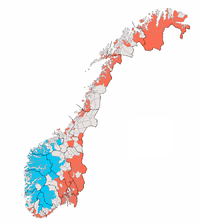
Official written language in the municipalities (as of 2007): Bokmål/Riksmål Nynorsk neutral

Flag of the Sami
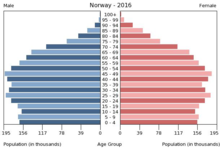
Population pyramid Norway 2016
Questions and Answers
Q: What is the capital of Norway?
A: The capital of Norway is the city of Oslo.
Q: How many people live in Norway?
A: About 5 million people live in Norway.
Q: What language is spoken by most Norwegians?
A: Norwegian is the national language spoken by most Norwegians.
Q: Are there any official written versions of Norwegian?
A: Yes, there are two official written versions of Norwegian called Bokmål and Nynorsk.
Q: Who is the head of state in Norway?
A: The head of state in Norway is King Harald V (as of 2022).
Q: What day celebrates Norway's constitution from 1814?
A: May 17th celebrates Norway's constitution from 1814.
Q:What languages are spoken by those who speak one of Norway's 3 Sami languages?
A:The Northern Sami language is spoken by around 90% of those who speak one of Norway's 3 Sami languages.
Search within the encyclopedia
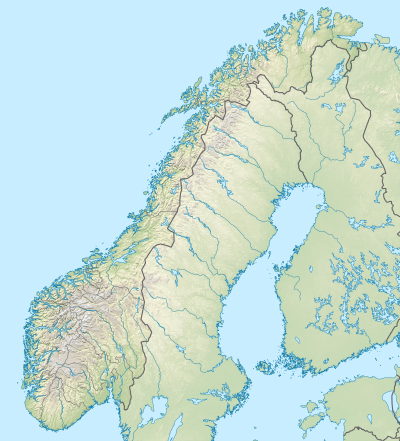
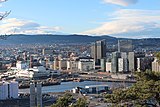
.jpg)
